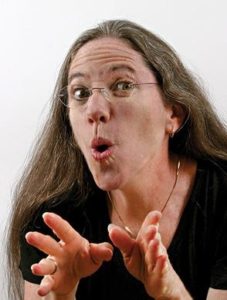At the National Storytelling Network, our mission is to advance all forms of storytelling within the community through promotion, advocacy and education.
New Interview Series…STORY NOW!
The theme of our 2019 annual conference was Story Now!
Now! From the boardroom to the classroom, and the page to the stage, personal stories and folktales are catalysts for change in every aspect of our lives.
Now! We are witnessing the power of stories to tear down the walls that divide us, build bridges between people and cultures, and connect us, human-to-human.
In this interview series we’ll talk to storytellers who exemplify this Story Now! movement.
Each month we’ll sit down with an NSN member or member organization, from around the globe, and go behind the scenes to explore how they are personally harnessing the power of storytelling to tear down walls, to be a catalyst for change and connect us human-to-human. Through one-on-one, in-depth conversations, we’ll discover the type of storytelling they do, how they do it, who their audience is and, most important, they’ll give examples of the real world, tangible results they get.
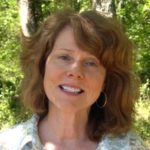 Kathy Greenamyre is NSN’s Community Relationships Builder. She will be conducting interviews and contributing content each month for our Story Now! Interview Series. Kathy is the owner of a video production company. She’s interviewed hundreds of people over the past 12+ years. Her passion is to discover the world (and maybe even learn how to fix it) through listening to, recording and spreading personal stories..
Kathy Greenamyre is NSN’s Community Relationships Builder. She will be conducting interviews and contributing content each month for our Story Now! Interview Series. Kathy is the owner of a video production company. She’s interviewed hundreds of people over the past 12+ years. Her passion is to discover the world (and maybe even learn how to fix it) through listening to, recording and spreading personal stories..
Karen Golden – Los Angeles, California
Kathy Greenamyre: You started a unique school for kids that incorporates storytelling in its curriculum. Tell us about it.
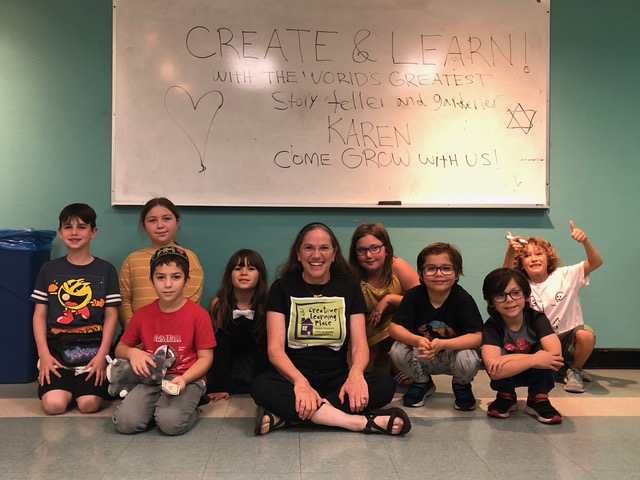 Karen Golden: Creative Learning Place (CLP) is a learning center that specializes in classes for homeschooled students and their families. We offer 60 enrichment classes a week for students in grades K – 12 in a wide variety of subjects, including, English, Live Action Role Play (LARP) science, game design, chess, sewing, cooking, science, math, robotics, ping pong, history, visual arts, filmmaking, gardening, theater, music, and of course storytelling. We currently have 120 students.
Karen Golden: Creative Learning Place (CLP) is a learning center that specializes in classes for homeschooled students and their families. We offer 60 enrichment classes a week for students in grades K – 12 in a wide variety of subjects, including, English, Live Action Role Play (LARP) science, game design, chess, sewing, cooking, science, math, robotics, ping pong, history, visual arts, filmmaking, gardening, theater, music, and of course storytelling. We currently have 120 students.
You may be thinking, wait, shouldn’t homeschoolers be at home? The word “homeschool” really ought to be called “parent directed education,” where parents have a choice on how to educate their children. Being at home is only part of the equation. Our center is the best of a school (interactive hands-on learning, teachers who care, group discussions, and plenty of social time) without the worst of a school (large classes, bullying, and mindless homework). It is a safe place that is always bustling with energy and vitality from our enthusiastic students to our inspired teachers. All of our students and teachers want to be there engaging in the process of learning. We are a unique community of diverse people coming together for a common cause: Inspiring children to be life-long learners.
KG: Another unique aspect of your school is that it’s a family-run operation. What’s the backstory?
K. Golden: I started CLP 11 years ago for my daughter Soli who is now 21 and a senior at UCLA. She was homeschooled for grades K – 12 and her older sister Hyla was homeschooled until 6th grade. Now Hyla and my husband Steve are teachers at CLP so we have a family business. Hyla teaches elementary and middle school English and Women in History and Steve teaches World History, Current Events, Drawing, and two classes for young students age 5 – 7 who are learning to read, write and use numbers.
KG: I know story work plays a major role in your school. In what way?
K. Golden: Since you are interviewing me for a storytelling audience I would like to focus on where story enters the picture at CLP. My lens for most of my life is through the lens of a storyteller. I am a story sponge and I love to make connections between people based on their stories.
When I first receive a call from a parent who has decided to homeschool their child I ask them the story of why they have made this decision and it can go several different ways. Some of them come from a positive experience and are looking to enhance their homeschooling life, such as, “Hello, we are interested in CLP because we want to live a homeschooling lifestyle. We have the means and the desire to be involved in our kid’s education. We want to make the world our classroom, because we are adventurers and travelers, and we own a piece of land in an eco-village in Mexico and are building a house there. We want the freedom to travel back and forth” Or perhaps I hear, “My child is an actor or athlete and has more important things to do than sit in school all day. CLP seems like our answer because your classes are once a week like at a university.” Sometimes I hear, “My daughter is only nine but has the comprehension of a 15-year-old. Can she attend your high school classes?” These are the positive stories and these students have families who have decided to devote their lives to their kid’s education. I call this “homeschooling by choice.” My own family fit this perspective, and a number of my students have this story.
On the other hand, this is not the only story I hear. Unfortunately, I also hear quite frequently, “My child was bullied in school and now they are afraid to go…or my child was failing in school and the school couldn’t help them anymore…or my child has a learning difference…or my child is autistic.” Or even, “my son was sick for two years and missed school and now the neighborhood school wants to put him in 3rd grade and he should be in 5th grade. He will feel sad and not make any friends. This is a recipe for disaster.”
These stories are often told by parents who are afraid, lost, and stuck. They feel their kids are broken and they don’t know how to pick up the pieces and put them back together. They are “homeschooling by default.” There is a beautiful story by Richard Kennedy about a girl who puts together a broken porcelain plate and instead of the pieces reforming a plate the pieces become a man, he breaks and she puts together the pieces expecting a man and they become a horse that takes her away. This story reminds me of many of my students. In the process of the pieces coming back together the child transforms into something other than what the parent thought they should be. At CLP we support each child to be on their own unique journey.
When children are actively involved in making decisions about their education, they may become entirely different people than what their parents expected. Last year a boy came to CLP who was very broken by a mental health and a physical challenge. His parents were mainly concerned about him staying on grade level. He was disinterested in learning. I suggested that he join our theater program and not worry so much about grades. At first, he didn’t like this class because he felt self-conscious about dancing. He stuck it out and not only did he act in the play, he was put back together in a new way and he discovered he is an actor. He LOVED the play and more importantly, he loved this process of learning.
I tell my families all the time that staying on grade level is not as important as feeling positive about education. Most families have an inaccurate narrative regarding education. Education should not be about filling a child’s head with facts and ideas as if the head is a vessel. Education is a process and the emphasis should be on making the process positive.
KG: Please elaborate on the type of stories you hear about individual students. How do you help them find success with the non-standard education you offer?
K. Golden: The first thing I do is listen. As a storyteller it is equally important to be a story listener. Often a parent will tell a story about their child that is a narrative that was told by someone else. “My son was kicked out of six schools and he will never succeed in life. He is a failure.” I say to the parent, “I hear a different story. I hear that your son doesn’t fit into the box called ‘School.’ He is unique and is on a different path. Let’s try to figure out how to make his journey positive and where he is headed.” This is not so difficult when we allow the child to identify what makes them “light up” about education. Maybe they want to learn about video game programming, or maybe they are a natural care giver.
Most schools try to change the student to fit their story rather than try to identify the student’s story. At a traditional school the day is so packed with classes, testing, busywork and discipline that the focus is not on finding the unique path of each student. Everyone needs to go together because there is only one shepherd and the herd is large. If a sheep strays to find a greener pasture they are quickly herded back rather than encouraged to find that pasture. I believe that a positive education allows students to find their greener pasture.
KG: How do you use storytelling to teach multiple subjects? Please give examples.
K. Golden: I teach a variety of subjects each week through what I call immersive storytelling. Immersive storytelling involves engaging the audience through a story framework that can be infused with educational content, role playing, problem solving and opportunities for personal growth. The next best thing to being there!
In my “Nature Stories,” “Story Geography,” and “Gardening Club” classes” my classroom can become an ancient Incan Temple where students create the soundscape of the jungle and join together to produce a rainstorm. Without realizing it, students will learn a creation myth, a few words from the Ancient Quechan language the science behind rain and the music of the rain forest.
I tell both folkloric stories and myths and I create original stories like the “Journey of the Redwood Seed “to explain the role of fire in the germination of this seed, or the “Amphibian Hokey Pokey” to explain how the tadpole turns into a frog.
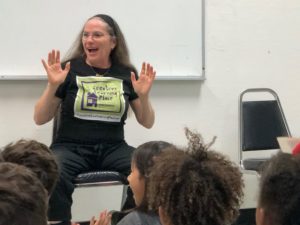 I also teach “Story Circle” where teens can talk about their lives in a safe and supportive space. Sometimes I tell a folktale and the students tell the mirror of this story to reflect how it is true in their lives. We also play a variety of story games and create original stories. I don’t allow the students to write in the class. This frees them to rely on creating orally and this is a new skill for most.
I also teach “Story Circle” where teens can talk about their lives in a safe and supportive space. Sometimes I tell a folktale and the students tell the mirror of this story to reflect how it is true in their lives. We also play a variety of story games and create original stories. I don’t allow the students to write in the class. This frees them to rely on creating orally and this is a new skill for most.
In addition, I teach recorder to young children, ages 5 – 7. This class is based on simple stories that are illustrated with the recorder sounds. Mother bird sings a song and baby bird answers. I add to this story each week and my students are engaged in playing, barely realizing they are learning a difficult skill for a young child: how to listen to and play music.
Some of my other teachers also use storytelling in their classrooms. We have a Live Action Role Play (LARP) teacher on our staff who teaches a variety of subjects using educational LARPing. Last year he taught chemistry and astronomy and the students acted out the solar system and became the elements in the periodic table. This semester he is teaching a Role Play Game Design class where students learn how to create their own interactive story games.
Our theater program is also based on storytelling as our teacher takes excerpts from literature and weaves them together to create a theatrical experience with music and dance. This year the subject is American Literature.
KG: You hire teachers based on their stories, not their credentials. Explain. Do you have an example of a teacher you hired based on mainly their story?
K. Golden: I use storytelling when I hire teachers for CLP. Because we are a learning center and not a school, my teachers do not need to be credentialed. It is important for me to hire teachers who are experts in their fields and passionate about what they teach in addition to being good teachers. In my interview process I ask prospective teachers to tell me stories about their lives. Most of my teachers find me rather than me finding them so they have heard about CLP. Last year a young man contacted me and said he is a telescope operator and he would love to teach astronomy, but he would not be available until the following year because he was going on a big adventure. I asked him what kind of adventure and he said he was walking across Spain. I don’t hear this every day, so I asked him many questions. Luckily for me, and my students, he contacted me a year later and now he is teaching astronomy and a class called “Backpacking Adventures” where he is teaching students how to prepare for a backpacking trip including what to pack, what to wear and where to go. He is preparing students to find the adventures that are the inspiration for great stories.
KG: You’ve said you make sure you know every teacher’s story to be sure they’re a good fit. What does your process look like in uncovering their stories?
K. Golden: In gathering the stories of my teachers, I need to make sure they are a fit for CLP. I look for teachers who have stories of self-directed learning rather than university degrees and credentials. It is important that these stories include how they have used what they know to inspire others. My physiology teacher also loves to draw, and she is teaching a class called “Anatomy and Physiology: Follow In DaVinci’s Footsteps.” Each student is making a book of their own drawings based on the life story of Leonardo DaVinci. My “Filmmaking: From Script To Screen” teacher is a former CLP student who is passionate about making YouTube videos based on her own stories. The students are creating a movie together. I am most excited when I am approached by a parent or teacher who has heard about CLP and they say, “I am really excited by X and I would love to teach this at CLP.” Our classes are very unique and have included “Harry Potter Genetics,” “Build A House: A How to Guide,” and even “Cartooning, Character Design and Cosplay,” which is being offered by our art teacher this semester. We also offer ASL, where among other things, the students learn to tell stories in sign language.
KG: Give examples of tangible/measurable results & successes that can be directly correlated with the storytelling aspects of your curriculum.
K. Golden: Now, more than ever, educators talk about assessment. Did my students remember what I tried to teach them? In my storytelling classes I can tell a story in week one and at the end of the semester in week 18 my students will still remember that fire is needed to germinate a redwood seed or coffee was first discovered, according to a myth, by the Yemenite in Ethiopia, and Mocha is a city in Yemen. Years later they still remember. Stories are memorable but facts alone are not. This is proof enough for me that storytelling is an important teaching tool.
KG: Tell one, two or more personal stories of students and/or their family members who have directly benefited from storytelling
K. Golden: Wow! I have so many stories I don’t know where to begin. When students are given a unique education to meet their needs, they flourish. One such story is of a boy who spent a lot of time playing video games. He joined CLP and began to take my Story Circle class. For the first few years in my class, (he has now been in the class for seven years) he mainly talked about the stories in his video games and the characters he met in these games, but he rarely talked about himself or ventured to create any original content. Over the years he has gained self-esteem and confidence, because unlike school, he is not compared with other students and he is celebrated for who he is. At CLP, in addition to taking academic classes like English and history, he also takes classes like Chess, and he is a great chess player. FYI, our chess class has a huge story component because our chess teacher uses the game as a metaphor for life. The game pieces come to life as character studies for his students. Last year this student was given the honor of “Chess Player of the Year” by our teacher. Because he feels safe and supported, he feels comfortable telling stories about his life, and he creates wonderful, original stories. Now he is one of my best storytellers. I have witnessed many students lose their shyness. I could write a book, and maybe I will someday, with stories of transformation about students who became passionate learners when given the chance to find their own green pastures.
KG: Talk a bit about where you were born and about the family you grew up in.
K. Golden: I was born in Flint, Michigan and my parents were both doctors. They hoped I would become a doctor, but this was not my calling. My parents shared an old Victorian house that was their office for 50 years. As a child I loved telling stories to their patients in the waiting room.
They were both great storytellers and every night we sat down as a family to eat dinner. I am the youngest of six children and my parents would tell stories about their medical practices, and my father loved to tell stories in Yiddish, which was both of my parent’s native language. He was born in Lithuania and both of my mom’s parents were also born in Lithuania. From a very early age I fell in love with storytelling. I also loved to exaggerate, because when you are the baby in a family of eight this may be the only way to be heard at the dinner table.
KG: Any early influences that might have led you to a career in storytelling?
K. Golden: I started my career in storytelling after interviewing a storyteller on my radio talk show in Flint, Michigan. I was a talk show host for three years on a public radio station. When my guest told me about a storytelling festival, I was intrigued enough to attend it. After I heard Jackie Torrence tell stories at the festival, I knew that I had found my calling. I had previously lived in Israel for seven years and received a MA in Communication Research from Hebrew University and I returned to Flint to be closer to my family. Up until this point I felt like I was not on the right path.
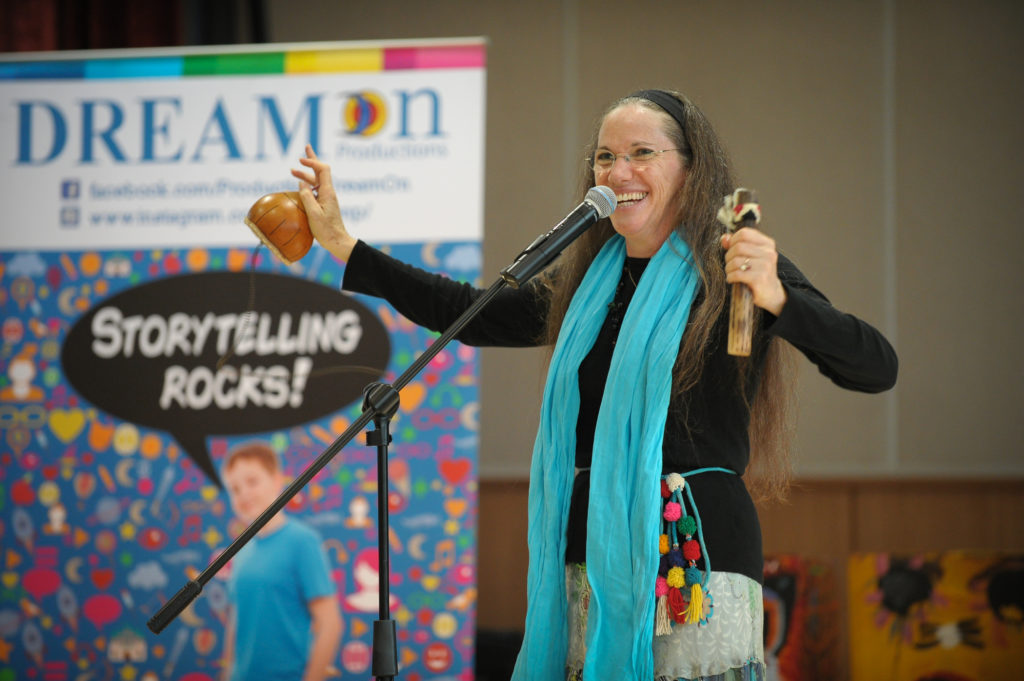 Finding storytelling gave me a direction. Before having children, I moved to Los Angeles and steadfastly began my career as a performance storyteller/musician, recording artist, writer, and a teacher of the art of storytelling. The thought of starting a learning center (school) never entered my mind. It was not until I had children that I began to blend my storytelling with education in the ways I do now. I am still a performance storyteller/musician, writer and a teacher of the art of storytelling in addition to running CLP, but this is not the focus of this interview. You can read about that on my website karengolden.com, or in my LA Voyage interview at the link below.
Finding storytelling gave me a direction. Before having children, I moved to Los Angeles and steadfastly began my career as a performance storyteller/musician, recording artist, writer, and a teacher of the art of storytelling. The thought of starting a learning center (school) never entered my mind. It was not until I had children that I began to blend my storytelling with education in the ways I do now. I am still a performance storyteller/musician, writer and a teacher of the art of storytelling in addition to running CLP, but this is not the focus of this interview. You can read about that on my website karengolden.com, or in my LA Voyage interview at the link below.
KG: How do you promote and market yourself/your business?
K. Golden: I have a website for my school, “Creative Learning Place”, a Meetup group “Creative Learning Place Homeschool Support”, a Facebook group “Creative Learning Place”, and many of my students find me through the charter schools that I partner with. In California, we have a unique educational choice where families can register for a homeschool charter school which is a school without a building, and the state gives them funding to homeschool through vendors. CLP is a vendor for eight public homeschool charter schools. We administer the education and are paid through public education money. I also have private pay students that find me by word of mouth and on the internet.
KG: In the years since you started your school, what has surprised you?
K. Golden: The biggest surprise is that I have continued doing this after my daughter has moved on from my program. I built this for her and now I homeschool other kids. It is a lot of work and sometimes I feel overwhelmed with the responsibility. On any given day I might receive ten or more emails, calls or texts from parents who are struggling with their child’s education and they are panicking or just plain freaking out. I have to calm them down and support them on the scary path of homeschooling. I need to convince them that they can do this, and they are not ruining their child or their child’s chances of attending a four-year university. After all, my own child went from homeschooling K – 12 to attending UCLA.
KG: What has surprised your students and their parents about your brand of teaching?
K. Golden: Many of my parents are pleasantly surprised at how much more family time they have once they decide to homeschool. For some, the tension leaves their home. For others, the tension rises because parents may have a personality clash with their own kids. Some families think they really know their kids and once they start to homeschool they see a side of their children they didn’t know was there. There are always many surprises.
KG: You were recently featured in LA Voyage Magazine (see link to article below). Congratulations! How did that come about?
K. Golden: I am pleased that I was interviewed by LA Voyage. I was recommended by an old friend.
KG: How did you find the National Storytelling Network?
K. Golden: Before NSN was called the National Storytelling Network, I found NAPPS in 1988.
A little history lesson…
When NSN was still part of the International Storytelling Festival in Jonesborough, TN, the joint organization (NSN + the festival) was called, the National Association For The Preservation And Perpetuation of Storytelling (NAPPS). A mouth full!
In 1988 when I was reading a library book and NAPPS was mentioned, I wrote a post card and requested more information and I joined. This was right after I saw Jackie Torrence at the Flint Storytelling Festival. I attended a week-long storytelling class in the summer of 1988 given by Laura Simms in Jonesborough, and this was my first introduction to storytelling. In July,1989 I was the emcee at the Flint Storytelling Festival and in October 1989 I moved to Los Angeles and hung out my “Storyteller for Hire” sign. Every month I looked forward to receiving the NAPPS Magazine, and I started attending the conferences the next summer.
KG: What made you want to join NSN (formerly NAPPS)?
K. Golden: I joined because I wanted to learn more about the art of storytelling, and I wanted to be in contact with like-minded people.
KG: How long have you been a member in total?
K. Golden: 30 years.
KG: What have been the benefits of being a member of NSN?
K. Golden: The benefits have included learning about the uses of storytelling from around the world, connecting with other storytellers, and finding storytelling resources.
KG: Finally Karen, what could NSN provide to help you grow your storytelling business?
K. Golden: I wear two hats as a storyteller. I am a performer/educator/writer, and the director of an education center. Both of these are my storytelling businesses. NSN could help connect me with festivals, conferences, venues and other performance and teaching opportunities so I can perform and lead workshops. NSN could also connect me to other people who have a similar vision of a paradigm shift in education, where storytelling is used as the main purveyor of educational material. I always love meeting and learning from like-minded people.
To contact and follow Karen:
Website: https://www.creativelearningplace.com/
Website: https://www.karengolden.com/
Phone: 323-839-9569
Email:
Facebook group: https://www.facebook.com/groups/414980718525676/
Karen’s Voyage LA Interview: http://voyagela.com/interview/meet-karen-golden-storyteller-creative-learning-place-inc/?fbclid=IwAR3oRSDM728TT0GFnTPWG2oMQhr-rkj8siPhFbXvhMMvDzTBjwjDdmi2W9s
NSN loves publishing items submitted by the storytelling community! If you’re interested in writing something for publication on the NSN website, newsletter, or Storytelling Magazine please contact the NSN office for more information.
Contact the National Storytelling Network
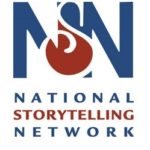 c/o Woodneath Library
c/o Woodneath Library
8900 N.E. Flintlock Road
Kansas City, MO 64157
Telephone: (800) 525-4514
Website: https://storynet.org
Email:
Find us on social media!
Facebook: https://www.facebook.com/National-Storytelling-Network-217381542906/
Twitter: https://twitter.com/NSNStorytellers
Instagram: https://www.instagram.com/nationalstorytellingnetwork
YouTube: https://www.youtube.com/channel/UCBedmDdaRi9N-4Hs-QeYNqw

